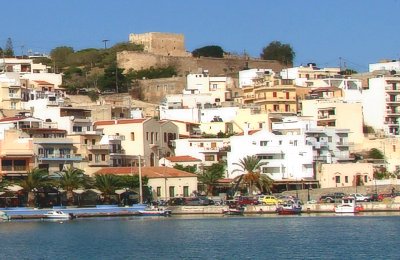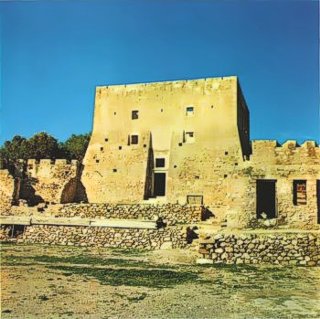Sitia is a small and pleasant coastal town, built in a semicircle on the western side of the Bay of Sitia, a typical, peaceful Mediterranean port.
It is the capital of the county with the same name and is sited 69 km east of
Agios Nikolaos.

Visitors in Sitia particularly enjoy the climate and the wonderful beaches. The highest temperature in the summer is approx. 30 C. and the lowest in winter is 7 C.
Sitia is the seat of administrative and public services for the county and has
road and
sea connections with various places in the island and with Pireaus and other Aegean islands. There is also a small
airport with connection to Athens, Kassos, Karpathos, Rhodes.
History
The name Sitia is derived from the ancient city of
Itia, birthplace of one of the seven wise-men of the antiquity,
Mison.
In the site that the town is built today only few archaeological findings have been excavated. Middle-Minoan and Late-Minoan tombs, Geometrical and Hellenic statues and shells, Roman buildings and an Early-Christian Basilica.
Sitia existed during the Late-Minoan period and until the Venetian period. During the Venetian occupation the town of Sitia was destroyed three times. In 1508 by a terrible earthquake, in 1538 by the pirate Barbarosa and in 1651 by the Venetians so as not to fall in the hands of the Turks.
For two centuries Sitia ceased to exist as a town, until 1869.
The present city was built in 1870. Since then, Sitia is developing to one of the most important urban areas in Crete.
Sights
 Kazarma
Kazarma
The most imposing monument of the past that dominates Sitia is the fortress of the castle today called Kazarma from the "Casa di Arma".
Kazarma was one of the buildings of Medieval Sitia, and it served as soldier's barracks and army headquarters.
Kazarma and the imposing wall around it were originally built in the Late Byzantine period. The walls were repaired by the Venetians many times and especially after the terrible earthquake of 1508 and the attack by the pirate Barbarosa in 1538.
The Roman fish-tanks
The Roman fish-tanks are placed 150 m from the Customs office. They are semicircular constructions on the shore within which the Romans kept their fish fresh .
There are ten fish-tanks in a 200 m coast. Most of them are ruined. The bigger and most well-preserved of them has the shape of a horseshoe and its dimensions are 7 by 6,75 m.
Tripitos
Tripitos is a small peninsula sited 3 km from Sitia. An artificial shelter for ships dug in the rocks, has been found there and is dated from the Hellenistic period.
A Hellenistic city extends to all the peninsula, and several parts of its settlements have been excavated, as well as its strong wall in the south part of the city.
A big number of clay pots, coins, jewels and lead weights have been excavated. The excavations are still going on today.
Sitia's deposits
The deposits of Sitia are cavities on the ground where the ancient people placed their offerings to the Gods.
They are dated from the 1050-500 BC.
They were probably placed next to a sanctuary that has not been excavated yet. Several idols, pots and sculptured tiles were found in these deposits, and today are exhibited in the Archaeological Museums of Sitia and Agios Nikolaos.
This location is considered the most important archaeological finding of Sitia.

Erotokritos
Sitia is the birth place of the great poet
Vintsenzos Kornaros, who wrote a masterpiece of Medieval poetry,
"Erotokritos".
The poem narrates the story of the princess
Aretousa, daughter of the king of Athens Hercules, and
Erotokritos, son of Pezostratos, member of the king's court.
Sitia possesses an excellent library and an important
Folklore Museum, with many exhibits, mainly handwoven materials, embroideries, local costumes, furniture.
There is also an
Archaeological Museum where significant archaeological finds of the area are exhibited.
The Museum exhibits cover a period of 4000 years, from 3500 BC to 500 AD.
An event that should not be missed by the visitor, is the celebration of soultanina (a type of raisin) that takes place every August in Sitia.
It is a public feast that is famous beyond the borders of the island.
In Sitia the visitor can find many hotels, pensions and houses with rooms for rent, as well as a youth hostel.
There are also many restaurants, taverns and cafes in the city and along the quay side.
Although the town is increasingly developing, it keeps its traditional character and the hospitable character of its people. The people are polite and friendly.
The Touristic Club of Sitia, the Cultural Center of the Municipality of Sitia and the educational and cultural association "Vintsenzos Kornaros", play an important role to the cultural life of the city.
In particular the "Vintsenzos Kornaros" association has founded the library and the Folklore Museum in Sitia.
Sitia is a good starting point for several excursions throughout Eastern Crete.
Some of the most important places to visit are Toplou Monastery, Palaikastro, Vai, Zakros, Makri Gialos, Itanos.
Video about the area of Sitia
| Useful Information |
Port Authority
Airport Authority
Police Station
Hospital
|
+30-28430-22310
+30-28430-22270
+30-28430-22259
+30-28430-24312
|